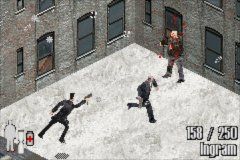Retro Replay Review
Gameplay
Max Payne on the Game Boy Advance retains the core mechanics that made the original PC title a cult classic, while adapting them to fit the handheld’s unique constraints. The isometric perspective offers a fresh take on the trademark third-person shooter action, demanding careful navigation of tight corridors and multi-level environments. Controls are responsive, with the shoulder buttons mapped intuitively for strafing and strafing shots, ensuring that players can dive into bullet time and unleash their arsenal with precision.
(HEY YOU!! We hope you enjoy! We try not to run ads. So basically, this is a very expensive hobby running this site. Please consider joining us for updates, forums, and more. Network w/ us to make some cash or friends while retro gaming, and you can win some free retro games for posting. Okay, carry on 👍)
The hallmark bullet time mechanic translates surprisingly well to the GBA’s smaller screen. Activating slow-motion transforms hectic firefights into cinematic set-pieces, allowing you to weave through enemy fire and line up headshots with cinematic flair. Although the frame rate takes a minor dip during extended bullet time sequences, it never undermines the core thrill of raining down lead on Max’s adversaries. The result is a pulse-pounding rhythm that keeps every encounter engaging.
Variety in weaponry is another strong point. From the trusty 9mm pistol to the thunderous shotgun, each armament feels distinct in weight and handling. Ammo is scarce, so players must balance aggression with tactical caution—ducking behind cover, timing dives, and exploiting bullet time judiciously. Enemy AI adapts across levels, sometimes flanking or taking cover themselves, which pushes you to vary your approach rather than charge in headlong.
Graphics
Given the limitations of the Game Boy Advance hardware, Max Payne’s graphics are remarkably faithful to the original game’s noir-inspired aesthetic. The isometric vantage point lends a diorama-like quality to each environment, where moody lighting and shadowed corners evoke the gritty atmosphere of dark alleyways and rain-slicked rooftops. Sprite work is detailed, and character animations—especially Max’s trademark dives—flow smoothly despite the system’s modest capabilities.
Environmental variety keeps the visuals fresh, from dingy underground clubs to opulent crime lord hideouts. Textures are clear, and clever use of palette swapping differentiates levels without overtaxing the hardware. Bullet-riddled walls and spent shell casings give each firefight tangible weight, reinforcing the sense that you’re tearing through a living, breathing underworld.
Cutscene transitions are handled through comic book–style panels, much like the PC original. These artfully rendered stills convey narrative beats without requiring full-motion video, preserving storage space while enhancing the game’s graphic novel vibe. Voice clips are absent, but on-screen text is concise, evocative, and punctuated by Max’s sardonic internal monologue—proof that style and narrative cohesion needn’t be sacrificed on a handheld platform.
Story
At its core, Max Payne on GBA tells the familiar tale of a man driven to the brink by unimaginable loss. The brutal slaying of Max’s wife and child sets the stage for a relentless quest for vengeance. From the opening moments, the game wastes no time plunging you into a world of betrayal, corruption, and moral ambiguity—echoing the bleak, pulp-infused storytelling that defined the original PC release.
Although the GBA’s storytelling toolkit is more modest than a home console’s, it delivers plot points with clarity and flair. The comic-panel interludes do more than break up the action; they deepen Max’s character by offering glimpses of his tortured psyche. Each narrative beat—from narrow escapes to shocking revelations—feels charged with emotion, ensuring that players remain invested in every step of the investigation.
Supporting characters, both allies and antagonists, are sketched out through terse dialogue and contextual stage design. You’ll encounter crooked cops, ruthless mob bosses, and mysterious femme fatales, each encounter nudging you closer to the game’s climactic confrontations. While the GBA adaptation trims some subplots from the PC version, it retains the essential twists and moral complexity that keep the storyline compelling from start to finish.
Overall Experience
Max Payne on the Game Boy Advance stands as a remarkable adaptation, showcasing how a storied franchise can be distilled into a portable format without losing its signature edge. The fusion of isometric gameplay, strategic bullet time sequences, and gripping narrative ensures that the game feels both fresh and faithful to its roots. Whether you’re a veteran seeking a new twist on a beloved title or a newcomer wanting a cinematic shooter on the go, this GBA rendition delivers.
Replay value is bolstered by hidden secrets and alternate routes through certain stages, encouraging exploration and mastery of each level’s geometry. Unlockable extras—such as gallery art and behind-the-scenes insights—add incentive for completionists to squeeze every drop of content from the cartridge. The challenge level strikes a careful balance, offering spikes that demand real skill while avoiding unfair “cheap hits” common in lesser portable shooters.
Ultimately, Max Payne on GBA proves that quality storytelling and innovative gameplay aren’t exclusive to high-end consoles. Its faithful preservation of bullet time, combined with a smart reimagining of camera angles and controls, results in an engaging handheld experience. For fans of action-packed revenge dramas and anyone craving a deep, atmospheric shooter on the go, Max Payne delivers a knockout performance.
 Retro Replay Retro Replay gaming reviews, news, emulation, geek stuff and more!
Retro Replay Retro Replay gaming reviews, news, emulation, geek stuff and more!









Reviews
There are no reviews yet.